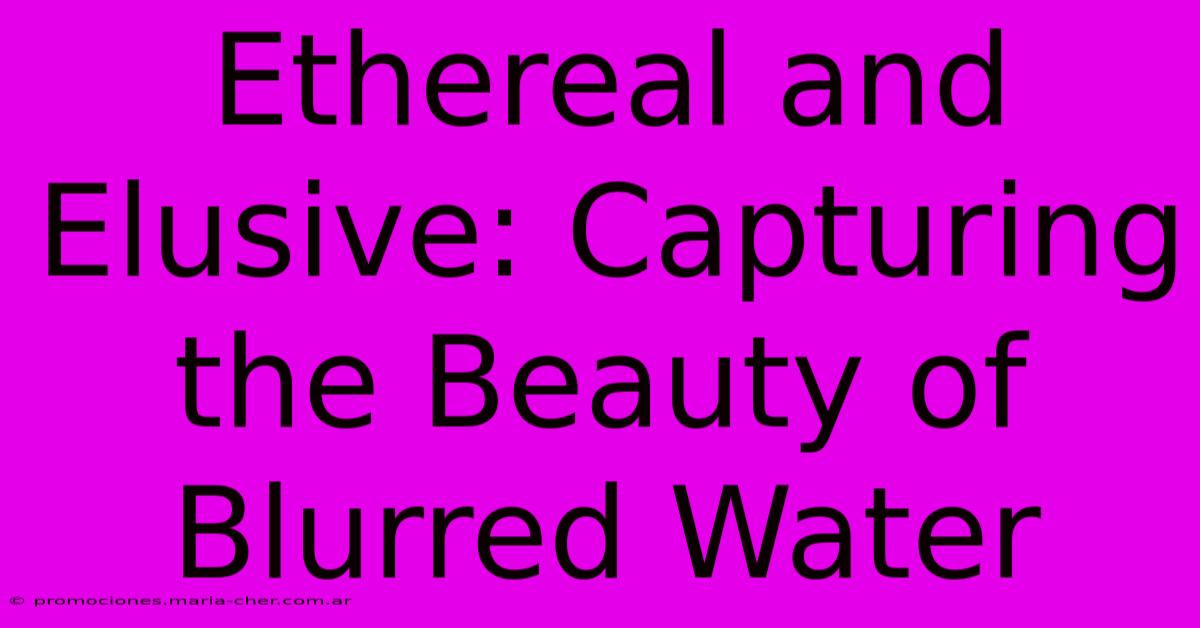Ethereal And Elusive: Capturing The Beauty Of Blurred Water

Table of Contents
Ethereal and Elusive: Capturing the Beauty of Blurred Water
Water, in its stillness and motion, has captivated artists and photographers for centuries. But there's a particular magic found in the blurred, ethereal quality of moving water – a captivating aesthetic that evokes a sense of mystery, tranquility, and the fleeting nature of time. This article will explore the art of capturing this elusive beauty, offering tips and techniques to help you achieve stunning results in your own photography.
The Allure of Blurred Water Photography
The beauty of blurred water lies in its abstract quality. Unlike crisp, sharp images of still water, blurred water creates a sense of movement, energy, and fluidity. It transforms a familiar scene into something dreamy and almost surreal. This effect can be used to enhance various moods and styles, from serene landscapes to dynamic action shots.
Why Blurred Water is Visually Appealing
- Movement and Energy: The blur suggests motion, conveying a feeling of dynamism and life. It draws the viewer's eye and creates a sense of narrative.
- Dreamlike Quality: The soft, diffused lines create an ethereal atmosphere, lending an almost dreamlike quality to the image.
- Emphasis on other Elements: Blurring the water can help draw focus to other elements in the scene, like a sharp rock formation or a vibrant sunset.
- Abstract Art: Blurred water can create beautiful abstract compositions, allowing you to focus on textures, shapes, and colors rather than precise details.
Techniques for Capturing Blurred Water
Achieving the perfect blur requires understanding your camera settings and the characteristics of the water itself. Here are some key techniques:
1. Slow Shutter Speeds: The Key to the Blur
The fundamental element in blurring water is using a slow shutter speed. This allows the motion of the water to be recorded as a blur during the long exposure. Experiment with shutter speeds ranging from a fraction of a second to several seconds, depending on the speed of the water and the desired effect. A tripod is crucial for sharp images at slow shutter speeds.
2. Aperture and ISO Settings
- Aperture: A relatively small aperture (high f-stop number, like f/8 or f/11) will help maintain a large depth of field, keeping both the foreground and background relatively sharp while blurring the water.
- ISO: Keep your ISO low (ISO 100-400) to minimize noise in your images, especially important when using slow shutter speeds.
3. Neutral Density (ND) Filters: Essential for Bright Conditions
In bright daylight, you'll likely need a Neutral Density (ND) filter to reduce the amount of light entering your lens. ND filters allow you to use slower shutter speeds even in bright conditions, essential for achieving that beautiful water blur.
4. Choosing the Right Location and Time
The location you choose significantly impacts the final image. Look for locations with flowing water – waterfalls, rivers, streams, or even ocean waves. The time of day also matters; consider shooting during the "golden hour" (sunrise or sunset) for warm, soft lighting that complements the blurred water.
Post-Processing for Enhanced Results
While capturing the perfect blur in-camera is crucial, post-processing can further enhance your images. You can use editing software like Adobe Lightroom or Photoshop to:
- Adjust Exposure and Contrast: Fine-tune the brightness, contrast, and overall tones to achieve the desired mood.
- Selective Adjustments: Use masking or other techniques to selectively adjust the blur or sharpness of different parts of the image.
- Color Grading: Experiment with different color grading techniques to create a specific atmosphere (e.g., cool and serene or warm and vibrant).
Beyond the Basics: Creative Approaches
Once you master the fundamental techniques, explore more creative approaches:
- Long Exposures and Light Trails: Combine blurred water with light trails from car headlights or city lights for a truly magical effect.
- Black and White Conversions: Converting your images to black and white can emphasize texture and form, creating a timeless and classic aesthetic.
- Water Reflections: Capture reflections of the surrounding environment in the blurred water, creating a sense of depth and symmetry.
Mastering the art of capturing blurred water takes practice and patience, but the results are well worth the effort. By understanding the techniques outlined above and experimenting with different approaches, you can capture truly ethereal and elusive images that showcase the unique beauty of moving water. Don't be afraid to experiment and find your own style!

Thank you for visiting our website wich cover about Ethereal And Elusive: Capturing The Beauty Of Blurred Water. We hope the information provided has been useful to you. Feel free to contact us if you have any questions or need further assistance. See you next time and dont miss to bookmark.
Featured Posts
-
A Timely Thank You Appreciating The Gift Of Prompt Communication
Feb 10, 2025
-
Dn Gurus Confession The Gel Vs Lacquer Holy Grail For Perfect Manicures
Feb 10, 2025
-
Luminous Awakening Uncover The Secrets Of Colors Brilliance L Value
Feb 10, 2025
-
Elevate Your Skills The Secret To Unlocking Your Graphic Design Potential As A Black Student
Feb 10, 2025
-
Pumpkin Perfection Discover The Ultimate Fall Nail Inspiration With Dnd Gel Polish
Feb 10, 2025
